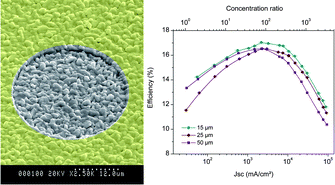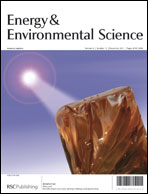Resistive and thermal scale effects for Cu(In, Ga)Se2 polycrystalline thin film microcells under concentration†
Abstract
Using solar cells under concentrated illumination is known to improve the conversion efficiency while diminishing the active area, and thus material consumption. Recent concentrator cell designs tend to go to smaller devices, in the 0.5–1mm lateral range, enabling a better thermal evacuation due to higher surface to volume ratio. If the cell size is further reduced to the micrometric range, spreading resistance losses can be made vanishingly small. This is particularly interesting for thin film technology which has been limited up to now to very low concentrations, 1–10 suns, due to excessive resistive losses of the window layer and difficult thermal management of the cells, grown on glass substrates. In order to prove that high injection regime can be implemented on polycrystalline thin film solar cells, we fabricated Cu(In, Ga)Se2 (CIGS) thin film microcells with diameter from 7 μm to 150 μm, and characterized them under concentrated illumination. A 4% absolute efficiency increase is obtained at 120 suns, and current densities as high as 100 A cm−2 can be measured, without affecting the cell performances. The temperature increase under high fluxes is drastically reduced in microcells: less than 20 K at 1000 suns for microcells under 50 μm in diameter. These results show that the use of polycrystalline thin films under high concentration is indeed possible, with important technological consequences.

- This article is part of the themed collection: Advanced inorganic materials for photovoltaics

 Please wait while we load your content...
Please wait while we load your content...